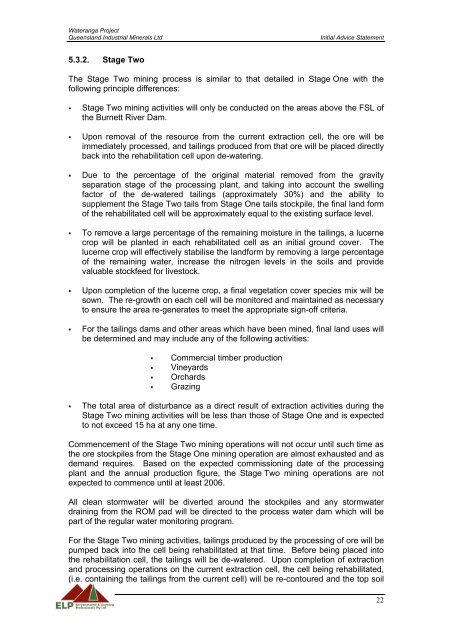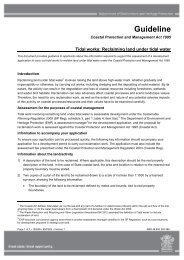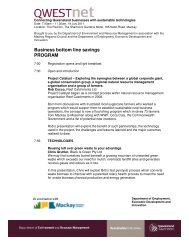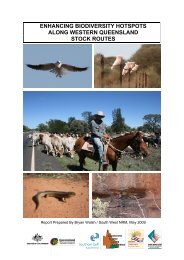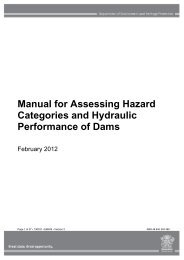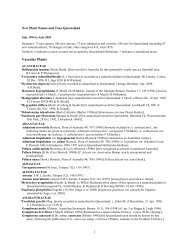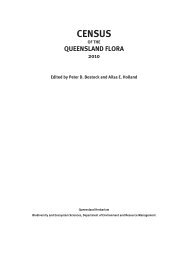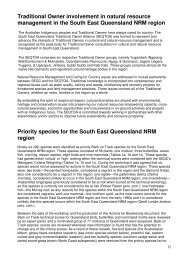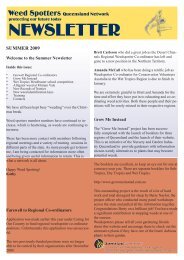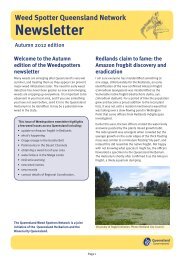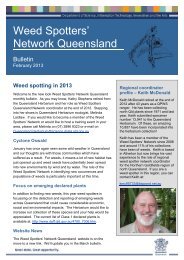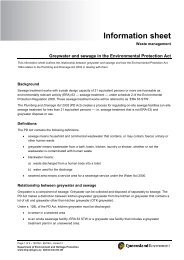WATERANGA PROJECT - Department of Environment and Heritage ...
WATERANGA PROJECT - Department of Environment and Heritage ...
WATERANGA PROJECT - Department of Environment and Heritage ...
You also want an ePaper? Increase the reach of your titles
YUMPU automatically turns print PDFs into web optimized ePapers that Google loves.
Wateranga Project<br />
Queensl<strong>and</strong> Industrial Minerals Ltd Initial Advice Statement<br />
5.3.2. Stage Two<br />
The Stage Two mining process is similar to that detailed in Stage One with the<br />
following principle differences:<br />
Stage Two mining activities will only be conducted on the areas above the FSL <strong>of</strong><br />
the Burnett River Dam.<br />
Upon removal <strong>of</strong> the resource from the current extraction cell, the ore will be<br />
immediately processed, <strong>and</strong> tailings produced from that ore will be placed directly<br />
back into the rehabilitation cell upon de-watering.<br />
Due to the percentage <strong>of</strong> the original material removed from the gravity<br />
separation stage <strong>of</strong> the processing plant, <strong>and</strong> taking into account the swelling<br />
factor <strong>of</strong> the de-watered tailings (approximately 30%) <strong>and</strong> the ability to<br />
supplement the Stage Two tails from Stage One tails stockpile, the final l<strong>and</strong> form<br />
<strong>of</strong> the rehabilitated cell will be approximately equal to the existing surface level.<br />
To remove a large percentage <strong>of</strong> the remaining moisture in the tailings, a lucerne<br />
crop will be planted in each rehabilitated cell as an initial ground cover. The<br />
lucerne crop will effectively stabilise the l<strong>and</strong>form by removing a large percentage<br />
<strong>of</strong> the remaining water, increase the nitrogen levels in the soils <strong>and</strong> provide<br />
valuable stockfeed for livestock.<br />
Upon completion <strong>of</strong> the lucerne crop, a final vegetation cover species mix will be<br />
sown. The re-growth on each cell will be monitored <strong>and</strong> maintained as necessary<br />
to ensure the area re-generates to meet the appropriate sign-<strong>of</strong>f criteria.<br />
For the tailings dams <strong>and</strong> other areas which have been mined, final l<strong>and</strong> uses will<br />
be determined <strong>and</strong> may include any <strong>of</strong> the following activities:<br />
Commercial timber production<br />
Vineyards<br />
Orchards<br />
Grazing<br />
The total area <strong>of</strong> disturbance as a direct result <strong>of</strong> extraction activities during the<br />
Stage Two mining activities will be less than those <strong>of</strong> Stage One <strong>and</strong> is expected<br />
to not exceed 15 ha at any one time.<br />
Commencement <strong>of</strong> the Stage Two mining operations will not occur until such time as<br />
the ore stockpiles from the Stage One mining operation are almost exhausted <strong>and</strong> as<br />
dem<strong>and</strong> requires. Based on the expected commissioning date <strong>of</strong> the processing<br />
plant <strong>and</strong> the annual production figure, the Stage Two mining operations are not<br />
expected to commence until at least 2006.<br />
All clean stormwater will be diverted around the stockpiles <strong>and</strong> any stormwater<br />
draining from the ROM pad will be directed to the process water dam which will be<br />
part <strong>of</strong> the regular water monitoring program.<br />
For the Stage Two mining activities, tailings produced by the processing <strong>of</strong> ore will be<br />
pumped back into the cell being rehabilitated at that time. Before being placed into<br />
the rehabilitation cell, the tailings will be de-watered. Upon completion <strong>of</strong> extraction<br />
<strong>and</strong> processing operations on the current extraction cell, the cell being rehabilitated,<br />
(i.e. containing the tailings from the current cell) will be re-contoured <strong>and</strong> the top soil<br />
22


